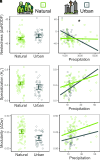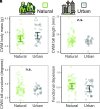Urban environments increase generalization of hummingbird-plant networks across climate gradients
- PMID: 39527750
- PMCID: PMC11621834
- DOI: 10.1073/pnas.2322347121
Urban environments increase generalization of hummingbird-plant networks across climate gradients
Abstract
Urbanization has reshaped the distribution of biodiversity on Earth, but we are only beginning to understand its effects on ecological communities. While urbanization may have homogenization effects strong enough to blur the large-scale patterns in interaction networks, urban community patterns may still be associated with climate gradients reflecting large-scale biogeographical processes. Using 103 hummingbird-plant mutualistic networks across continental Americas, including 176 hummingbird and 1,180 plant species, we asked how urbanization affects species interactions over large climate gradients. Urban networks were more generalized, exhibiting greater interaction overlap. Higher generalization was also associated with lower precipitation in both urban and natural areas, indicating that climate affects networks irrespective of habitat type. Urban habitats also showed lower hummingbird functional trait diversity and over/underrepresentation of specific clades. From the plant side, urban communities had a higher prevalence of nonnative nectar plants, which were more frequently visited by the hummingbird species occurring in both urban and natural areas. Therefore, urbanization affected hummingbird-plant interactions through both the composition of species and traits, as well as floral resource availability. Taken together, we show that urbanization consistently modifies ecological communities and their interactions, but climate still plays a role in affecting the structure of these novel communities over the scale of continents.
Keywords: Latin America; Neotropics; functional diversity; pollination; urbanization.
Conflict of interest statement
Competing interests statement:The authors declare no competing interest.
Figures





References
-
- Santangelo J. S., et al. , Global urban environmental change drives adaptation in white clover. Science 375, 1275–1281 (2022). - PubMed
-
- Teixido A. L., et al. , Anthropogenic impacts on plant-animal mutualisms: A global synthesis for pollination and seed dispersal. Biol. Conserv. 266, 109461 (2022).
-
- Theodorou P., The effects of urbanisation on ecological interactions. Curr. Opin. Insect Sci. 52, 100922 (2022). - PubMed
-
- Guimarães P. R., The structure of ecological networks across levels of organization. Annu. Rev. Ecol. Evol. Syst. 51, 433–460 (2020).
MeSH terms
LinkOut - more resources
Full Text Sources

